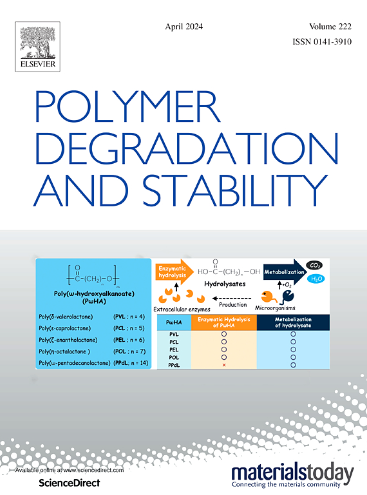一种磷菲接枝环硅氧烷与硅藻土复合的阻燃环氧树脂,具有优良的综合性能
IF 7.4
2区 化学
Q1 POLYMER SCIENCE
引用次数: 0
摘要
商用环氧树脂(EPs),特别是dgeba型环氧热固性树脂的核心缺点是易燃性和脆性,这限制了其应用。因此,提高EPs的阻燃性具有研究意义和应用价值。本研究采用有机-无机协同阻燃策略来提高环氧热固性材料的阻燃性。无机阻燃剂采用含磷硅烷偶联剂(DOPO-KH560)改性前后的硅藻土(DM),有机组分采用含磷环硅氧烷(DOPO-4Si)。所制备的EP复合材料具有优良的综合性能。EP/DOPO-4Si-1.0 p和EP/(DOPO-4Si+mDM)的极限氧指数(LOIs)分别达到30.5 %和28.5 %,UL-94垂直燃烧试验的V-0等级。此外,改性后的EP复合材料具有较低的放热率和排烟率。与EP相比,EP/(DOPO-4Si+mDM)的峰值放热率(PHRR)和总放热率(THR)分别降低38.9 %和19.3 %。改性后的环氧复合材料除具有良好的阻燃性能外,还表现出良好的强度。其中,EP/DOPO-4Si-1.0 p的拉伸强度和冲击强度分别达到47.5 MPa和52.7 kJ/m2, EP/(DOPO-4Si+mDM)的拉伸强度和冲击强度分别为42.7 MPa和27.2 kJ/m2。此外,通过对残炭和热解产物的分析,比较了EP复合材料的阻燃机理。本工作为有机-无机协同阻燃体系在高性能EP复合材料制备中的应用提出了一种新方法。本文章由计算机程序翻译,如有差异,请以英文原文为准。
A phosphaphenanthrene-grafted cyclosiloxane in combination with diatomite for flame retardant epoxy resins with excellent comprehensive properties
The core shortcomings of commercial epoxy resins (EPs), especially DGEBA-type epoxy thermosets, are their flammability and brittleness, which restrict their applications. Therefore, improving the flame retardancy of EPs has research significance and application value. In this study, an organic -inorganic synergistic flame retardant strategy was applied to improve the flame retardancy of epoxy thermosets. The inorganic flame retardant used was diatomite (DM) before and after modification with a phosphorus-containing silane coupling agent (DOPO-KH560), and phosphorus-containing cyclosiloxane (DOPO-4Si) was used as the organic component. The as-prepared EP composites had excellent comprehensive properties. The limiting oxygen indices (LOIs) of EP/DOPO-4Si-1.0P and EP/(DOPO-4Si+mDM) reached 30.5 % and 28.5 %, respectively, and the V-0 rating in the UL-94 vertical burning test. In addition, the modified EP composites resulted in a lower heat release rate and smoke release rate. Compared with those of EP, the peak heat release rate (PHRR) and total heat release (THR) of EP/(DOPO-4Si+mDM) were 38.9 % and 19.3 % lower, respectively. In addition to their flame retardant properties, the modified epoxy composites also exhibited good strengths. Specifically, the tensile and impact strengths of EP/DOPO-4Si-1.0P reached 47.5 MPa and 52.7 kJ/m2, respectively, whereas those of EP/(DOPO-4Si+mDM) were 42.7 MPa and 27.2 kJ/m2, respectively. In addition, the flame retardancy mechanisms of EP composites were compared via the analysis of char residues and pyrolysis products. This work proposed a new method for the application of organic-inorganic synergistic flame retardant systems in the preparation of high-performance EP composites.
求助全文
通过发布文献求助,成功后即可免费获取论文全文。
去求助
来源期刊

Polymer Degradation and Stability
化学-高分子科学
CiteScore
10.10
自引率
10.20%
发文量
325
审稿时长
23 days
期刊介绍:
Polymer Degradation and Stability deals with the degradation reactions and their control which are a major preoccupation of practitioners of the many and diverse aspects of modern polymer technology.
Deteriorative reactions occur during processing, when polymers are subjected to heat, oxygen and mechanical stress, and during the useful life of the materials when oxygen and sunlight are the most important degradative agencies. In more specialised applications, degradation may be induced by high energy radiation, ozone, atmospheric pollutants, mechanical stress, biological action, hydrolysis and many other influences. The mechanisms of these reactions and stabilisation processes must be understood if the technology and application of polymers are to continue to advance. The reporting of investigations of this kind is therefore a major function of this journal.
However there are also new developments in polymer technology in which degradation processes find positive applications. For example, photodegradable plastics are now available, the recycling of polymeric products will become increasingly important, degradation and combustion studies are involved in the definition of the fire hazards which are associated with polymeric materials and the microelectronics industry is vitally dependent upon polymer degradation in the manufacture of its circuitry. Polymer properties may also be improved by processes like curing and grafting, the chemistry of which can be closely related to that which causes physical deterioration in other circumstances.
 求助内容:
求助内容: 应助结果提醒方式:
应助结果提醒方式:


